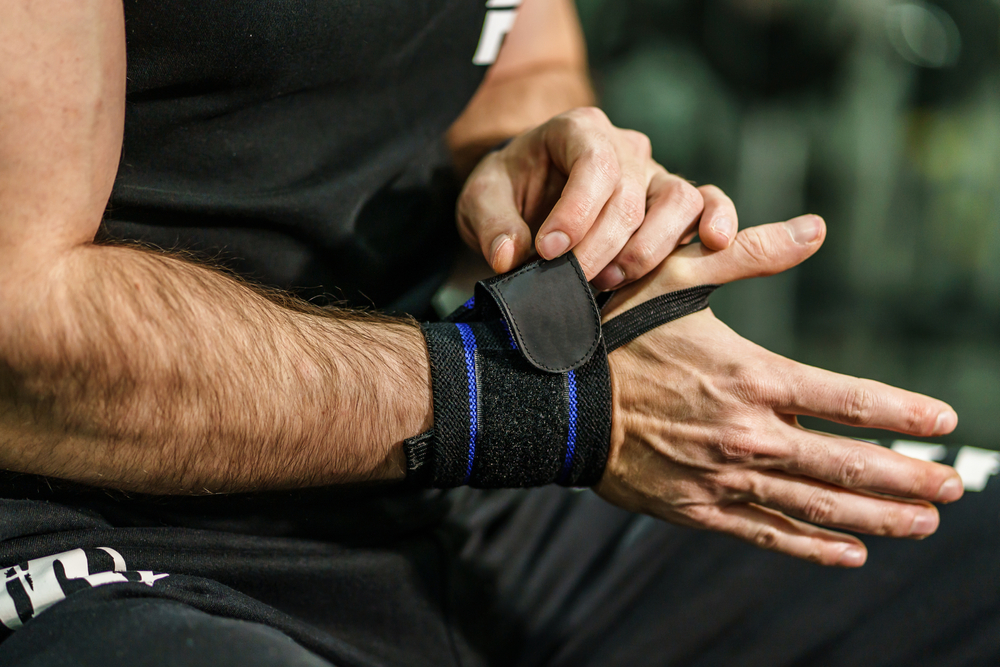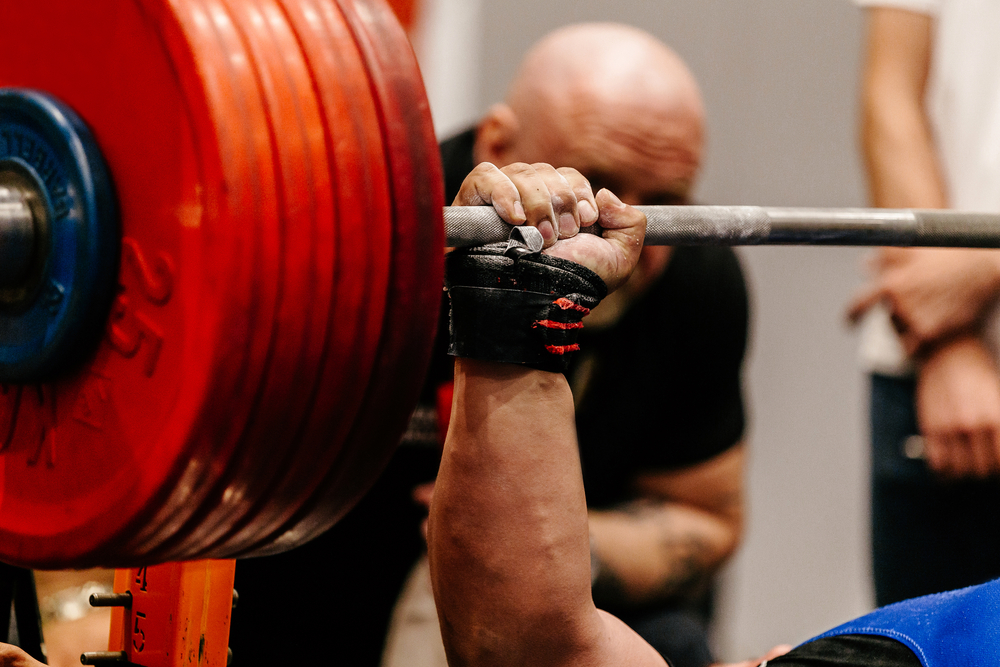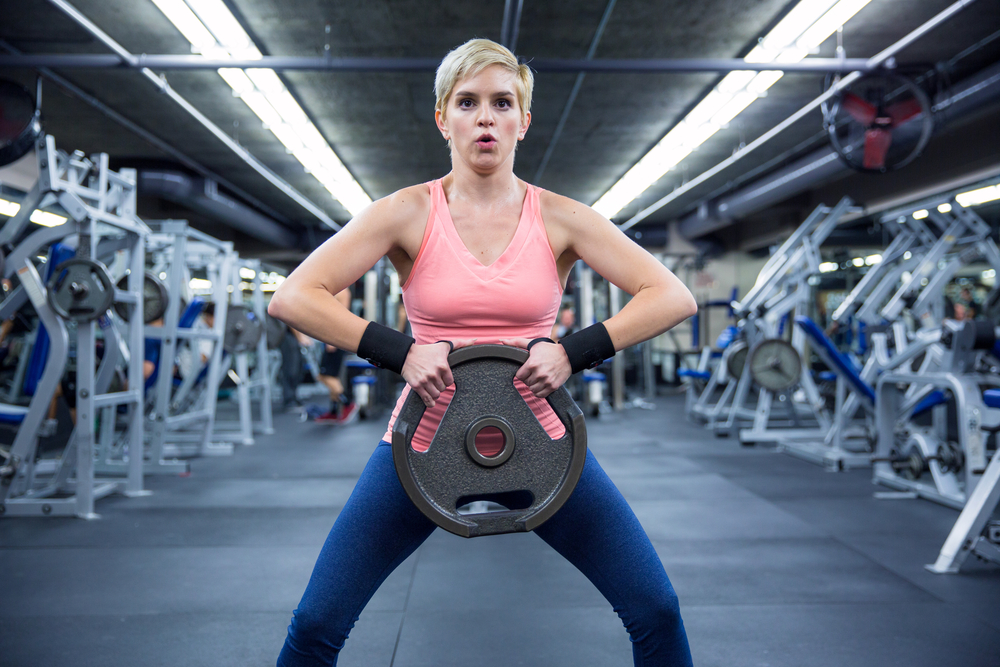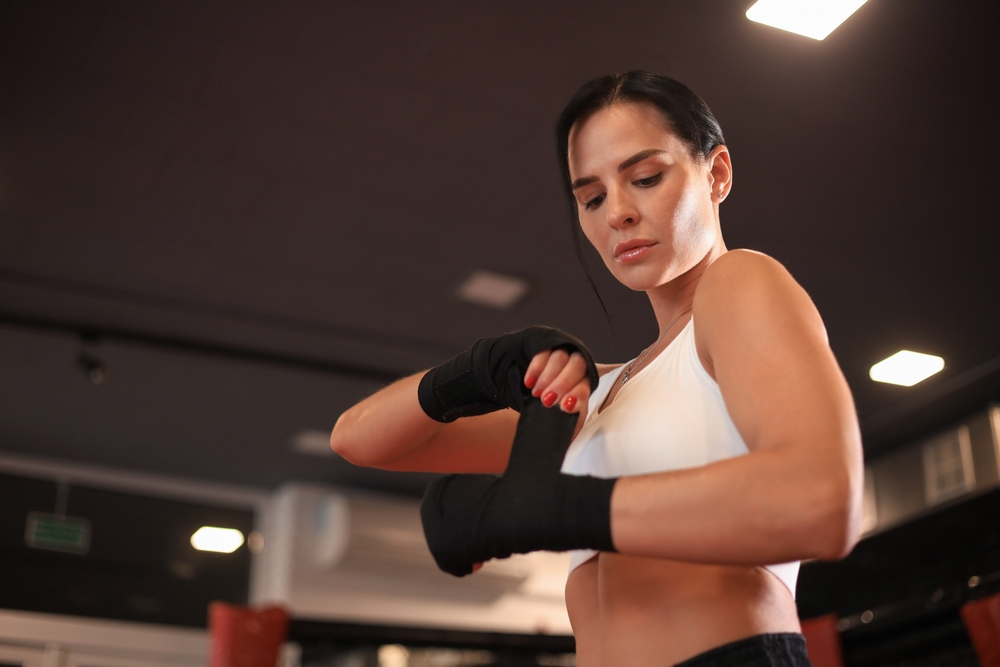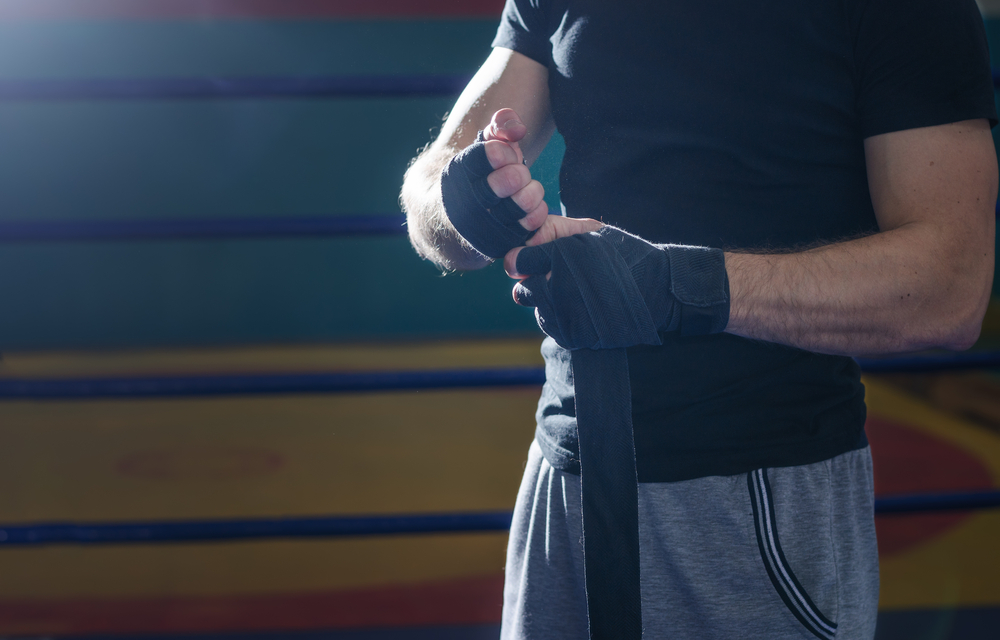We do our best to have every advantage during our workouts. This includes buying specially designed clothes with improved flexibility and breathability, spending hours researching shoes to find the best ones for running, lifting, or all-around training. Perhaps we research recovery techniques to keep us feeling our best so we can give 100% the next day in the gym. Finally, we take our training seriously, because we’re serious about our results.
The use of wrist wraps offers multiple benefits, such as providing protection to your wrist while encouraging greater performance during weightlifting. Proper use of wrist wraps also provides stability and support to the wrist joint. This allows you to push your limits, lift heavier, and enjoy greater gains in shorter time. They’re also portable, easy to use, and relatively inexpensive.
There’s a lot to love about wrist wraps. Let’s dive into what makes them so useful in the gym!
Contents
- What Are Wrist Wraps Good For?
- Are Wrist Wraps Necessary?
- Benefits of Wrist Wraps for Bench Press
- How Much Do Wrist Wraps Help Deadlift?
- What Weight Should I Start Using Wrist Wraps?
- How Long Should You Wear a Wrist Wrap?
- How to Wear Wrist Wraps
- Pros of Wrist Wraps
- Cons of Wrist Wraps
- Do Wrist Wraps Make You Weaker?
- Best Wrist Wraps for Lifting
What Are Wrist Wraps Good For?
Wrist wraps are good for heavy presses and overhead lifts. Basically, wrist wraps will help for any lift where your wrist is at risk for hyperextension. At lighter weights, there is less risk of your wrist bending back under the weight of the bar. As you increase the weight on the bar, the risk increases as well. Wrist wraps mitigate the risk by providing extra support and stability.
Are Wrist Wraps Necessary?
Wrist wraps are not necessary but recommended for heavier lifts.
Some people may feel that the lift doesn’t count if you use support like belts, wrist wraps, or wrist straps. In terms of the work your body is doing during the lift, it definitely counts.
You still receive the same benefits as performing the lift without the use of support. However, you’ll mitigate your risk of injury when pushing your limits.
Mitigating risk is the real reason you should use wrist wraps. Even the strongest weightlifters who regularly put up big numbers are still subject to fatigue. Maybe you push hundreds of pounds overhead often, but all it takes is one mistake. One instant of broken tension and your wrist will cock backwards and possibly cause severe wrist damage.
Benefits of Wrist Wraps for Bench Press
The bench press is popular for building overall strength and bulging chest muscles that would make Arnie proud. Using wrist wraps during a bench press provide many benefits.
1) Provides joint stability
On your opening set, you probably don’t need to wrap those wrists tight. Most people are able to handle light to moderate weight on a bar without issue.
Once you start racking heavier weight and pushing your limits, however, it’s prudent to wrap. Wrist wraps provide joint stability and will protect your wrists on heavy lifts or when fatigue sets in.
2) Staves off fatigue
When our muscles fatigue, it doesn’t happen all at once. First, smaller muscles that provide support to the larger ones start wearing out. Once those supporting muscles stop assisting, we begin taxing the bigger muscle until muscle failure.
And that’s how we reach our limit in a nutshell.
Wrist wraps help us push past by supporting the little muscles. Sure, we want strong muscles all around. However, you don’t want to bench below your actual ability just because your wrist muscles are fatigued. By simply adding wrist wraps, you can push beyond your limits and bench even more.
3) Provides support post-injury
Let’s start by saying that we fully recommend discussing any injury with your doctor before returning to physical activity. Wrist wraps are not a cure-all.
That said, your doctor may very well recommend wrist wraps as part of your recovery plan. Returning to the gym following an injury isn’t easy. It’s important to start light, scale gradually, and use tools to support our recovery.
Wrist wraps are one such tool that may be integral to your post-injury recovery plan.
4) Improves grip strength
Wrist wraps help you grip the bar better, which translates to an all-around better bench press. It’s remarkable that such a simple apparatus could accomplish this, but it makes total sense.
It all has to do with how the hands and forearms work. Most of the muscles that operate your fingers are in the forearm. By applying pressure to your wrist, you’ll notice your fingers start to curl into a closed fist. This is because the pressure forces a muscle contraction.
Essentially the wrist wraps are assisting the muscle contraction and helping you hold a tight grip on the bar.
5) Makes weight feel lighter in your hand
This benefit is one part proprioception and one part psychological.
Proprioception is more or less your body’s perception on a physical level. Factors such as joint position and movement, muscle force, and effort contribute to your proprioception. Improving your proprioception translates to a better feeling of strength and control during a lift.
And how do we improve our proprioception in a simple way? By putting on wrist wraps and forcing muscle rigidity from the tension.
Simply wrapping your wrists sends information through your body’s receptors that the same weight that may have just felt challenging now feels lighter. It’s not magic. It’s science!
There’s a psychological element at play here too. Wrapping your wrists likely will make you feel stronger and more protected against injury. This has an effect on our brain that helps us believe that we are now stronger, even though all we did was put on wrist wraps.
Never underestimate the power of perception or proprioception.
How Much Do Wrist Wraps Help Deadlift?
Wrist wraps help during a deadlift by improving your grip strength on the bar.
It seems like wrist wraps should not help with a deadlift because your wrist remains in a neutral position. It’s true that the main purpose of a wrist wrap is to prevent hyperextension. During a deadlift, hyperextending your wrist is near impossible.
However, wrist wraps apply pressure to the forearm which forces the muscles that close your fingers to contract. This simple feature guarantees a better grip on the bar, which is integral when deadlifting heavy weights.
Wrist straps, which are different from wrist wraps, are also helpful during a deadlift. They will hold the bar in case your grip fails but provide no wrist support whatsoever.
What Weight Should I Start Using Wrist Wraps?
Wrist wraps are best left for any weight that is 80% of your 1RM (one-rep max) or more.
Think about it. The main purpose of the wrist wrap is for preventing hyperextension by providing support and stability. At lower weights, your small muscle groups are already working to do that.
You may feel that a “better safe than sorry” approach is best and wear them anyway. However, this deprives your smaller muscle groups in your forearm from getting a good workout. These muscles will not necessarily weaken from the added support, but they won’t get stronger either. For this reason, wait until the going gets tough before going to get your wrist wraps.
How Long Should You Wear a Wrist Wrap?
Wrist wraps are best suited to wear during heavy lifts, then promptly removed. You won’t mind ripping them off right after either. They’re not made to be comfortable. They’re made to help you and protect you.
There are some situations when wearing wrist wraps for longer makes sense. For instance, CrossFit WODs with high rep sets of overhead presses or handstand push-ups like Grace, Isabel, or Diane.
Because WODs are scored by time, you don’t have the luxury of taking the wraps on and off over and over. It’s best to put on the wrist wraps before the WOD and take them off when you’re done.
How to Wear Wrist Wraps
Wrap your wrists effectively and correctly by following these steps:
- Start with your wrist bent forward. The purpose is to prevent it from being forced backwards. We want to limit side-to-side movement as well. Starting with a slight bend forward helps position the wrist right where we want it.
- Slip your thumb through the loop. This is optional, and you can tuck the loop into the wrap at the end if it’s annoying to you. For now, slip the thumb through the loop to help hold the wrap in the right place.
- Clench a fist. Try clenching now and feel what happens. Feel that strength in your forearm and wrist? That’s what we’re looking to hold during the lift. Starting out with a clenched fist is a simple and smart way to maximize the effect of the wrist wrap.
- Wrap the bottom of your palm. Aren’t these made for the wrists? Why would we wrap the bottom of the palm? It’s all about positioning. By placing the wrap higher up to include the bottom of your palm, it decreases the wrist’s mobility and improves stability. Once it’s wrapped, you shouldn’t be able to bend the wrist backwards even if you try.
- Gradually increase the tightness as you wrap. Start with moderate tightness and wrap tighter and tighter with each revolution. You don’t want to totally cut off circulation, but you need it firm. The wrap does you no good if it’s loosely hanging from your wrist.
- Velcro shut and get ready to lift!
Take your time on your first few wraps and check in with your body to make sure it feels right. You want a tight and strong wrap. You want it to keep that wrist positioned in the right place during the lift.
Once you’ve wrapped correctly a few times, you’ll be able to put them on just as quickly as taking them off. They’re simple and easy.
Pros of Wrist Wraps
Wrist wraps are an excellent tool for protecting your wrists while pushing your limits. There are many pros to using wrist wraps while lifting:
- Provide support and stability
- Give you confidence
- Help you push limits
- Assist in recovery post-injury
- Improve proprioception
- Easy to use
- Inexpensive
- Versatile
- Durable
- Portable
Wrist wraps are both a great tool and a great buy. A good pair will last you many years. For weightlifters that are looking to next level their lifts, wrist wraps are a good first piece of gear.
Cons of Wrist Wraps
There are some cons associated with using wrist wraps:
- They nurture dependency
- They deprive small muscles of training
- They’re uncomfortable
- They wear out over time
We can deal with the discomfort and the wear and tear. Everything wears out in time. The most concerning drawbacks, however, are the ones associated with dependency and training small muscle groups.
You want to train the whole body, not just your “pretty muscles” like back, chest, and biceps. Every small muscle that provides accessory support needs exercise just like the rest of them. Wrist wraps provide support, which effectively cuts out the support muscles from the lift or at least diminishes their contribution.
Over time, this keeps your support muscles growing less rapidly than your bigger muscles. You may physically be unable to lift heavier weights without the wrap. Even if you can, you may perceive that you can’t and start feeling a dependency on the gear.
To mitigate these factors, wait until lifting the heaviest weights of your set before breaking out the wrist wraps. For light and moderate weight, lift without them to give your other muscles some training too.
Do Wrist Wraps Make You Weaker?
Many people feel that wrist wraps are counterproductive. They think that your muscles will atrophy from receiving that added support. They think that wrist wraps will actually make you weaker.
This is false. Wrist wraps do not make you weaker.
It’s not totally unbased, however. Wrist wraps do pick up a lot of the support work, cutting certain muscles out of the lift. You’ll build small muscle groups faster without the use of wrist wraps. It’s recommended that you leave the wraps off during light and moderate lifts to cater to these muscles.
For large muscle groups like your shoulders and chest, it’s the opposite. Because your wrist has added protection from the wraps, you can push past your usual threshold and lift heavier weight. Lifting heavy will help you build strength and get a rock-solid physique more quickly than lifting moderate weights. And that’s often the whole point of training, isn’t it?
In this regard, wrist wraps actually are more likely to make you stronger, not weaker.
Best Wrist Wraps for Lifting
You want a high-quality wrist wrap to get the most positive effect on your workout. Wraps often come in 12-, 20-, or 36-inch options. Beginners are likely best using 20s, as the 12s often lack the length to pull the wrap tight.
Elastic, polyester, and cotton blends are excellent at providing a mix of elasticity, flexibility, and rigidity. 100% cotton is soft but is often less rigid than blends. For this reason, the best wrap will be a blend.
Inzer Atomic Wrist Wraps
The Inzer Atomic Wrist Wraps are some of the best you can get. They remain relatively inexpensive yet use high-quality materials and offer unparalleled power and control during the lift. It’s an excellent wrap and carries the IPF official approval to distinguish itself among competitors.
Rip Toned Wrist Wraps
Another great option is the Rip Toned Wrist Wraps. Available in an 18-inch option and 14 different color options, these wraps are USPA approved and endorsed by champion powerlifter Kevin Weiss. You’ll not only hit PRs using these bad boys, but you will look stylish too!
